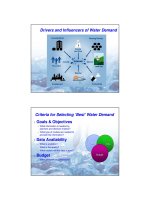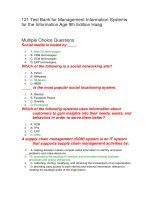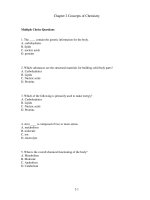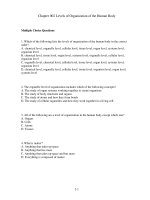New venture creation entrepreneurship for the 21st century 9th edition spinelli test bank
Bạn đang xem bản rút gọn của tài liệu. Xem và tải ngay bản đầy đủ của tài liệu tại đây (224.06 KB, 31 trang )
Chapter 02
The Entrepreneurial Mind: Crafting a Personal Entrepreneurial Strategy
True / False Questions
1. Entrepreneurs personally compete against others with self-imposed standards that
are realistic and challenging.
True
False
2. In the context of entrepreneurship, the need for power is about achieving
influence.
True
False
3. In the context of entrepreneurship, the need for affiliation relates to the
importance of key circles of influence.
True
False
4. Successful entrepreneurs often exhibit a strong need for status, money and
power.
True
False
5. One somewhat predictable research finding was that entrepreneurial leaders are
not patient individuals.
True
False
6. Almost without exception, entrepreneurs live under huge, constant pressures until
their firms have survived the startup phase; after that, it typically gets easier.
True
False
7. Successful entrepreneurs possess a well-developed capacity to exert influence
without formal power.
True
False
8. Successful entrepreneurs are likely to have accumulated the net worth and/or
credibility prior to starting their venture.
True
False
9. Evidence suggests that the most durable entrepreneurial careers, those found to
last 25 years or more, were begun at an earlier age before the person had made
any substantial commitments to a specific career path.
True
False
10. Many successful entrepreneurs do not have prior industry experience.
True
False
11. Entrepreneurs work longer and harder than managers in big companies.
True
False
12. The average age of entrepreneurs starting high-potential businesses is in the mid40s.
True
False
Multiple Choice Questions
13. Research has found that people are motivated by which of the following?
A. The need for achievement
B. The need for power
C. The need for affiliation
D. All of the above
14. Which of the following is the least characteristic driver of successful
entrepreneurs?
A. Achievement
B. Control
C. Power
D. Patience
15. Which of the following is not one of the three attributes that research has shown
underlie the success in a new venture?
A. The ability to respond positively to challenges and learn from mistakes
B. The ability to attract and motivate an effective team
C. Personal initiative
D. Perseverance
16. According to the authors, which of the seven dominant themes of
entrepreneurship is the most important?
A. Leadership
B. Opportunity Obsession
C. Courage
D. Commitment and Determination
E. Tolerance of Risk, Ambiguity and Uncertainty
F. Creativity, Self-Reliance, and Adaptability
G. Motivation to Excel
17. Which of the following attributes are not entrepreneurial?
A. Invulnerability
B. Perfectionist
C. Outer control
D. All of the above
18. An organization's needs are satisfied ___________ those of the other constituents
the enterprise serves.
A. in parallel with
B. before
C. after
D. None of the above; depends on the situation
19. Successful entrepreneurs consistently focus on what?
A. Market-based opportunity
B. Attracting resources
C. Networking
D. Making money
20. Successful entrepreneurs are likely to be older and have at least how many years
of experience?
A. 3
B. 5
C. 8
D. 12
21. In general, how long will venture capitalists work with a start-up before declaring
the company a 'lemon'?
A. Up to a year
B. About two and half years
C. At least three years
D. Three to five years
22. According to venture investors, what is a realistic time frame for growing a higher
potential business to the point where a capital gain can be realized?
A. 1-3 years
B. 2-5 years
C. 5-7 years
D. 7-8 years
23. Which of the following is not a paradox of entrepreneurship?
A. Flexibility vs. opportunity focus
B. Resource requirements vs. ownership
C. Age vs. experience
D. Drive and ambition vs. wisdom and judgment
24. Increasingly, research studies on the career paths of entrepreneurs and the selfemployed suggest that which of the following is the central factor in successful
venture creation?
A. Networking
B. The ability to marshal resources
C. Experience and know-how
D. The ability to attract and motivate an effective team
25. According to research, which of the following statements is false?
A. Many successful entrepreneurs do not have prior industry experience
B. Most successful entrepreneurs start companies by their late 20s
C. Most successful entrepreneurs follow a pattern of apprenticeship
D. Family firms spawn entrepreneurs
26. Crafting a Personal Entrepreneurial Strategy can
A. Create tension and pressure
B. Heighten the fear of failure
C. Spark action towards achievable goals
D. All of the above
27. Which is not true about self-assessment feedback?
A. It's hard to obtain
B. It's hard to receive
C. It's hard to benefit from
D. All are true
28. Which of the following is not a persistent myth about entrepreneurs?
A. Leaders are born, not made
B. Entrepreneurs are gamblers
C. Solo entrepreneurs limit their potential for growth
D. Entrepreneurs should be young and energetic
Fill in the Blank Questions
29. The ________ is the need to excel and for measurable personal accomplishment.
________________________________________
30. The ________ is the need to build a warm relationship with someone else and/or to
enjoy mutual friendship.
________________________________________
31. Successful entrepreneurs are not gamblers; they take ________.
________________________________________
32. Since entrepreneurs frequently evolve from an entrepreneurial heritage or are
shaped and nurtured by their closeness to entrepreneurs and others, the concept
of ________ can be a useful one.
________________________________________
33. Numerous studies show a strong connection between the presence of ________ in
their lives and the emergence of successful entrepreneurs.
________________________________________
34. Entrepreneurs can recognize the difference between a good idea and a viable
________.
________________________________________
35. Most successful entrepreneurs have had a ________ to help them achieve their
dreams and goals, both implicitly and explicitly.
________________________________________
36. Crafting a personal entrepreneurial strategy can be viewed as the personal
equivalent of developing a ________.
________________________________________
37. For a successful entrepreneur, seeking and using ________ is central to the habit of
learning from mistakes and setbacks, and of responding to the unexpected.
________________________________________
Short Answer Questions
38. Name the conceptual scheme for thinking about the self-assessment process
where there are two sources of information about the self: the individual, and
others.
39. What plays a significant role in influencing an entrepreneur's values, motivations,
attitudes, and behaviors?
Essay Questions
40. Discuss the concept of 'hero maker' with regard to entrepreneurial leadership.
41. In what ways is having Courage an important part of being an entrepreneur?
Chapter 02 The Entrepreneurial Mind: Crafting a Personal Entrepreneurial
Strategy Answer Key
True / False Questions
1.
Entrepreneurs personally compete against others with self-imposed standards
(p. 35)
that are realistic and challenging.
FALSE
Blooms: Remember
Difficulty: 2 Medium
2.
In the context of entrepreneurship, the need for power is about achieving
(p. 35)
influence.
TRUE
Blooms: Remember
Difficulty: 2 Medium
3.
In the context of entrepreneurship, the need for affiliation relates to the
(p. 35)
importance of key circles of influence.
FALSE
Blooms: Remember
Difficulty: 2 Medium
4.
Successful entrepreneurs often exhibit a strong need for status, money and
(p. 38)
power.
FALSE
Blooms: Remember
Difficulty: 1 Easy
5.
One somewhat predictable research finding was that entrepreneurial leaders
(p. 38)
are not patient individuals.
FALSE
Blooms: Remember
Difficulty: 3 Hard
6.
Almost without exception, entrepreneurs live under huge, constant pressures
(p. 39)
until their firms have survived the startup phase; after that, it typically gets
easier.
FALSE
Blooms: Remember
Difficulty: 2 Medium
7.
Successful entrepreneurs possess a well-developed capacity to exert influence
(p. 40)
without formal power.
TRUE
Blooms: Remember
Difficulty: 2 Medium
8.
Successful entrepreneurs are likely to have accumulated the net worth and/or
(p. 43)
credibility prior to starting their venture.
TRUE
Blooms: Remember
Difficulty: 2 Medium
9.
Evidence suggests that the most durable entrepreneurial careers, those found
(p. 44)
to last 25 years or more, were begun at an earlier age before the person had
made any substantial commitments to a specific career path.
FALSE
Blooms: Remember
Difficulty: 2 Medium
10.
Many successful entrepreneurs do not have prior industry experience.
(p. 45)
TRUE
Blooms: Remember
Difficulty: 2 Medium
11.
Entrepreneurs work longer and harder than managers in big companies.
(p. 46)
FALSE
Blooms: Remember
Difficulty: 2 Medium
12.
The average age of entrepreneurs starting high-potential businesses is in the
(p. 46)
mid-40s.
FALSE
Blooms: Remember
Difficulty: 2 Medium
Multiple Choice Questions
13.
Research has found that people are motivated by which of the following?
(p. 35)
A. The need for achievement
B. The need for power
C. The need for affiliation
D. All of the above
Blooms: Remember
Difficulty: 1 Easy
14.
Which of the following is the least characteristic driver of successful
(p. 36)
entrepreneurs?
A. Achievement
B. Control
C. Power
D. Patience
Blooms: Remember
Difficulty: 1 Easy
15.
Which of the following is not one of the three attributes that research has
(p. 37)
shown underlie the success in a new venture?
A. The ability to respond positively to challenges and learn from mistakes
B. The ability to attract and motivate an effective team
C. Personal initiative
D. Perseverance
Blooms: Remember
Difficulty: 2 Medium
16.
According to the authors, which of the seven dominant themes of
(p. 37)
entrepreneurship is the most important?
A. Leadership
B. Opportunity Obsession
C. Courage
D. Commitment and Determination
E. Tolerance of Risk, Ambiguity and Uncertainty
F. Creativity, Self-Reliance, and Adaptability
G. Motivation to Excel
Blooms: Remember
Difficulty: 2 Medium
17.
Which of the following attributes are not entrepreneurial?
(p. 39)
A. Invulnerability
B. Perfectionist
C. Outer control
D. All of the above
Blooms: Remember
Difficulty: 1 Easy
18.
An organization's needs are satisfied ___________ those of the other constituents
(p. 40)
the enterprise serves.
A. in parallel with
B. before
C. after
D. None of the above; depends on the situation
Blooms: Remember
Difficulty: 2 Medium
19.
Successful entrepreneurs consistently focus on what?
(p. 41)
A. Market-based opportunity
B. Attracting resources
C. Networking
D. Making money
Blooms: Remember
Difficulty: 1 Easy
20.
Successful entrepreneurs are likely to be older and have at least how many
(p. 43)
years of experience?
A. 3
B. 5
C. 8
D. 12
Blooms: Remember
Difficulty: 1 Easy
21.
In general, how long will venture capitalists work with a start-up before
(p. 44)
declaring the company a 'lemon'?
A. Up to a year
B. About two and half years
C. At least three years
D. Three to five years
Blooms: Remember
Difficulty: 2 Medium
22.
According to venture investors, what is a realistic time frame for growing a
(p. 44)
higher potential business to the point where a capital gain can be realized?
A. 1-3 years
B. 2-5 years
C. 5-7 years
D. 7-8 years
Blooms: Remember
Difficulty: 2 Medium
23.
Which of the following is not a paradox of entrepreneurship?
(p. 45)
A. Flexibility vs. opportunity focus
B. Resource requirements vs. ownership
C. Age vs. experience
D. Drive and ambition vs. wisdom and judgment
Blooms: Remember
Difficulty: 2 Medium
24.
Increasingly, research studies on the career paths of entrepreneurs and the self-
(p. 45)
employed suggest that which of the following is the central factor in successful
venture creation?
A. Networking
B. The ability to marshal resources
C. Experience and know-how
D. The ability to attract and motivate an effective team
Blooms: Remember
Difficulty: 2 Medium
25.
According to research, which of the following statements is false?
(p. 45,
47)
A. Many successful entrepreneurs do not have prior industry experience
B. Most successful entrepreneurs start companies by their late 20s
C. Most successful entrepreneurs follow a pattern of apprenticeship
D. Family firms spawn entrepreneurs
Blooms: Remember
Difficulty: 3 Hard
26.
Crafting a Personal Entrepreneurial Strategy can
(p. 49,
50)
A. Create tension and pressure
B. Heighten the fear of failure
C. Spark action towards achievable goals
D. All of the above
Blooms: Remember
Difficulty: 1 Easy
27.
Which is not true about self-assessment feedback?
(p. 50)
A. It's hard to obtain
B. It's hard to receive
C. It's hard to benefit from
D. All are true
Blooms: Remember
Difficulty: 1 Easy
28.
Which of the following is not a persistent myth about entrepreneurs?
(p. 46)
A. Leaders are born, not made
B. Entrepreneurs are gamblers
C. Solo entrepreneurs limit their potential for growth
D. Entrepreneurs should be young and energetic
Blooms: Remember
Difficulty: 2 Medium
Fill in the Blank Questions









